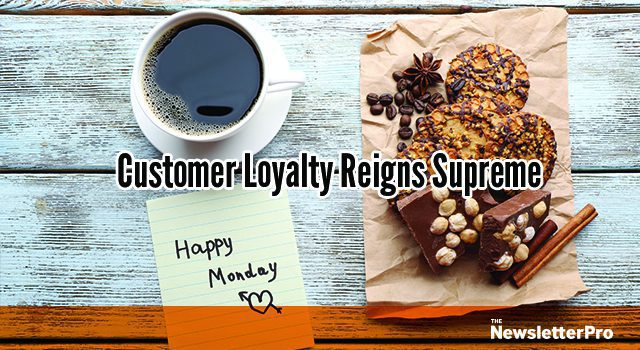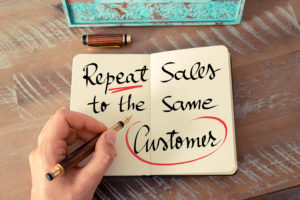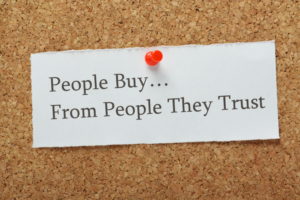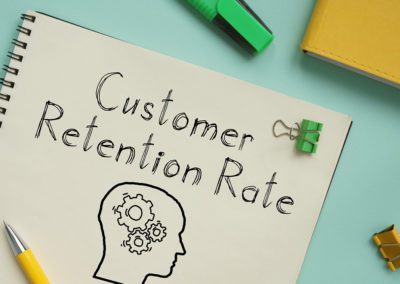If you knew the lifetime value and loyalty of a customer depended on their next interaction with you, would you treat them a little bit differently?

Fostering long-term relationships with your customers is an investment in your own profits. That’s why those relationships should be treated as seriously as any other financial investment.
Lifetime Value And Customer Loyalty
Think about the lifetime value of a customer. Developing loyalty among your customers results in a longer business relationship, increasing the value that one person brings to your company.
 The cost of acquiring a single customer includes marketing materials, labor, and time. If you’re able to get a customer to stick around and invest in your product or services, these costs will be mitigated, and your company will even profit from the relationship. One-time purchases, though, are often not enough to offset the acquisition costs. That’s why it’s important to promote customer retention and increase that lifetime value.
The cost of acquiring a single customer includes marketing materials, labor, and time. If you’re able to get a customer to stick around and invest in your product or services, these costs will be mitigated, and your company will even profit from the relationship. One-time purchases, though, are often not enough to offset the acquisition costs. That’s why it’s important to promote customer retention and increase that lifetime value.
When you think about a customer retention strategy, consider what your competitors are doing. What would jeopardize the loyalty your customers feel toward you?
It comes down to a sense of indifference and price. Personal relationships with your clients will trump a competitor’s lower prices or promotions. Purchasing decisions are not completely logical, and research proves that consumer emotions play a large role in loyalty and repeat business.
Customer Loyalty At Its Finest: A Girl And Her Coffee
Here is a true story of customer loyalty.
 Boise has no shortage of local coffee shops. In fact, several coffee shops downtown are within two minutes’ walking distance of each other. Caffeine addicts and college students alike have several options when it comes to their barista and coffee blends. As for me, I have a very special place in my heart (and cup holder) for Human Bean Coffee.
Boise has no shortage of local coffee shops. In fact, several coffee shops downtown are within two minutes’ walking distance of each other. Caffeine addicts and college students alike have several options when it comes to their barista and coffee blends. As for me, I have a very special place in my heart (and cup holder) for Human Bean Coffee.
First, the baristas at Human Bean have the best service I’ve experienced — fast, friendly, and accurate. They developed a loyalty program with punch-cards and seasonal specials. Their parking lot is easily accessible — double points in my book for avoiding inconvenient left-hand turns! And lastly, each beverage is topped with a complimentary chocolate-covered espresso bean.
If, on a rare occasion, a Human Bean barista takes longer than usual or forgets my extra shot of espresso, I’m inclined to forgive and forget. Our long history of positive experiences makes up for one or two missteps.
This relates to customer loyalty for most businesses. Customers form emotional attachments to brands that have proven to be trustworthy and consistent. That promotes repeat business, referrals, and positive word-of-mouth marketing. Customer retention is a valuable tool.
Acquisition Vs. Retention
 According to the White House Office of Consumer Affairs, it is up to 7 times more expensive to attract a new customer than it is to retain an existing one.
According to the White House Office of Consumer Affairs, it is up to 7 times more expensive to attract a new customer than it is to retain an existing one.
With the fast-approaching new year on the horizon, consider shifting your focus from simply finding prospects to keeping your current customers coming back for more. By focusing on repeat business, many companies are catching on to a retention strategy that promises to build momentum throughout the year.
#1 Retention Strategy: Direct Mail Marketing
That strategy is direct mail marketing. Although it’s not new, it has proven itself to outperform and outlast the most innovative digital campaigns.
Physical mail has proven effective over time because it focuses on relationships. These relationships turn into referrals and retention, which ensures your marketing investment doesn’t go to waste.
Here are a few reasons why, when it comes to customer retention, direct mail is king.
 Relationships: It is a fact of life that consumers prefer to do business with people they like and trust. The likeability factor is a powerful influence — more powerful than price, even. An American Express Survey in 2011 found that 7 in 10 Americans would be willing to spend more with companies that they believe provide excellent customer service.
Relationships: It is a fact of life that consumers prefer to do business with people they like and trust. The likeability factor is a powerful influence — more powerful than price, even. An American Express Survey in 2011 found that 7 in 10 Americans would be willing to spend more with companies that they believe provide excellent customer service.
Direct mail, and specifically a custom print newsletter, fosters this sense of positive customer service by allowing consumers to see the people behind the business. Receiving physical mail with relevant content also conveys a sense of exclusivity and importance. These factors are enormously helpful in keeping you top of mind with your customers. When they need a service you offer, you can bet your company will be the first one they think of. Customers see business with you as more than a transaction. They see a personal interaction.
Referrals: Brand advocacy and word-of-mouth marketing was identified by Forbes contributor Kimberly Whitler as the most valuable form of marketing. Why? Well, let’s see. Who’s advice would you trust more: a salesman’s or your best friend’s? Positive and negative word-of-mouth marketing is treated as less biased than advertisements. That’s because your friend typically does not have a stake in the success of the company.
In customer opinion surveys, 74% of consumers say that the opinions of family and friends are a key influencer in their decision making. A study by Van den Bulte, Skiera, and Schmitt found that referred customers have approximately 25% higher lifetime values than non-referred customers. Plus, they’re 18% less likely to churn.
Fortunately, these referrals and brand advocates are a specific focus of direct-mail campaigns. Monthly newsletters provide happy customers with something to talk about with family and friends. These physical mailers also have great pass-around value and staying power around the house or office. This gives people a reason to talk about your brand and start referring their friends and family. In fact, newsletters are the perfect platform to incentivize referrals!
Memorability: How can clients refer you if they don’t remember your name? Many businesses only see their customers a few times per year. It’s easy to forget great experiences or a likeable staff in the months between visits. Direct mail is one of the best ways to stay top of mind, because it not only builds a relationship and increases customer loyalty, but also uses informative articles and prestige to establish you as an expert in your field.
 As opposed to digital marketing, print media gains more attention and focus from your client. It’s physically in their hands with their name printed on the front. It’s not surrounded by the noise and clutter of a web page or sentenced to the spam folder in the inbox. It requires physical contact, which studies prove has a higher response rate in the brain than digital marketing. Don’t leave your retention strategy up to chance. Make sure that customers know you, like you, and choose you for their purchases moving forward.
As opposed to digital marketing, print media gains more attention and focus from your client. It’s physically in their hands with their name printed on the front. It’s not surrounded by the noise and clutter of a web page or sentenced to the spam folder in the inbox. It requires physical contact, which studies prove has a higher response rate in the brain than digital marketing. Don’t leave your retention strategy up to chance. Make sure that customers know you, like you, and choose you for their purchases moving forward.
Looking To 2017
We encourage you to start thinking about 2017 as the year that your business nails customer retention, loyalty, and referral programs. You are investing in a relationship with your customers when you implement a direct mail campaign. It’s a relationship that will not only keep them around, but will also improve your referrals, retention rates, and repeat businesses throughout the year.






